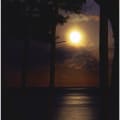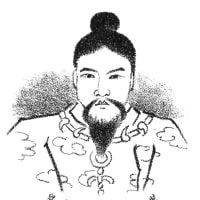『日本書紀』仲哀天皇 3
八年春正月己卯朔壬午、幸筑紫。時岡縣主祖熊鰐、聞天皇之車駕、豫拔取五百枝賢木、以立九尋船之舳、而上枝掛白銅鏡、中枝掛十握劒、下枝掛八尺瓊、參迎于周芳沙麼之浦、而獻魚鹽地、因以奏言「自穴門至向津野大濟爲東門、以名籠屋大濟爲西門、限沒利嶋・阿閉嶋爲御筥、割柴嶋爲御甂御甂、此云彌那陪、以逆見海爲鹽地。」既而導海路。自山鹿岬𢌞之入岡浦。
到水門、御船不得進。則問熊鰐曰「朕聞、汝熊鰐者有明心以參來、何船不進。」熊鰐奏之曰「御船所以不得進者、非臣罪。是浦口有男女二神、男神曰大倉主、女神曰菟夫羅媛。必是神之心歟。」天皇則禱祈之、以挾杪者倭國菟田人伊賀彥、爲*祝令祭、則船得進。皇后別船、自洞海洞、此云久岐入之、潮涸不得進。時熊鰐更還之、自洞奉迎皇后、則見御船不進、惶懼之、忽作魚沼・鳥池、悉聚魚鳥。皇后、看是魚鳥之遊而忿心稍解。及潮滿卽泊于岡津。
≪英訳≫
In the eighth year of spring, on the fourth day of the first month, Emperor arrived in Tsukushi. Upon hearing of the Emperor’s arrival, the ancestor of the OkanoAgatanushi, Wani, uprooted a large sacred sakaki tree, placed it at the bow of a large ship, hung a white bronze mirror on the upper branches, a ten-span sword on the middle branches, and an eight-foot jewel on the lower branches, and welcomed the party at Suwa no Saba (present-day Suo-Saba, Yamaguchi Prefecture) Bay.
The area for fishing and salt collection was presented as an offering. It was proposed to designate the area from Anato to Mukatsuno no Oowatari (present-day Usa, Oita Prefecture, and Mukaino) as the East Gate, Nagoya no Oowatari (present-day Nagoyasakai, Tobata, Fukuoka Prefecture) as the West Gate, and to set the limits with Motorishima and Ahenoshima (present-day Rokuren Islands and Ai Island) as the royal domains, dividing Shibashima to serve as the royal granary, and designating the sea of Sakame as the salt field.
A guide through the sea route was provided, entering Okaura from around Yamaga no Misaki. However, upon reaching the entrance, the ship could not move forward. Asked by Wani, it was questioned why the ship could not advance despite the Wani’s pure intentions. Wani explained that the immobility was not due to his fault but because of two deities residing in the bay, named Okuranushi (male deity) and Tsuburahime (female deity), suggesting their divine will might be the cause.
The Emperor prayed and appointed Igahiko, a navigator from the Yamato region (Uda people), as the ritualist (Hafuri) to perform the ceremony. Subsequently, the ship moved.
Empress Jingū, aboard a different ship, entered from the Kukinoumi but was stuck due to the receding tide. The Wani, attempting to return and welcome the Empress from Kukinoumi, was alarmed by the immobility of the ship and hastily constructed fish and bird ponds to gather fish and birds. Seeing these fish and birds, the Empress’s anger dissipated. As the tide rose, the Empress docked at Okatsu.
Note: “Hafuri" refers to a role, often under the direction of a Shinto priest, more directly involved in conducting rituals than a Negi (assistant priest).
≪この英文の和訳≫
春の八年目、一月の四日に、(仲哀)天皇は筑紫(つくし)に到着されました。天皇の到着を聞いた岡県主(おかのあがたぬし)の先祖である熊鰐(わに・くまわに)は、大きな榊(さかき)を根こぎにして、大きな船の舳(へさき)に立て、上の枝には白銅鏡(ますのかがみ)を、中央の枝には十握剣(とつかのつるぎ)を、下の枝には八尺瓊(やさかに 瓊 赤い玉)を吊るし、周芳沙麼(すわのさば、現在の山口県佐波)の浦で一行をお迎えしました。
漁と塩をとる区域を献上しました。穴門(あなと)から向津野(むかつの)大済(おおわたり、現在の大分県宇佐、向野)までを東門(ひがしのみと)とし、名籠屋大済(なごやのおおわたり、現在の福岡県戸畑の名籠屋崎)を西門(にしのみと)とすること、没利島(もとりしま)、阿閉島(あへのしま、現在の六連島、藍島)を限界として御笪(みたく 領地)とし、柴島(しばしま)を分けて御甂(みなへ 穀倉)とすること、逆見海(さかめのうみ)を塩地(しおじ 塩を採る地 塩田)とすることが提案されました。
海路(かいろ)を案内して、山鹿岬(やまがのみさき)から周りをめぐって岡浦(おかうら)に入りました。しかし、入口に着くと船は動かなくなりました。熊鰐(わに・くまわに)に尋ねられ、熊鰐は清らかな心を持っているにもかかわらず、なぜ船が進まないのかと問われました。熊鰐は、動かないは自分の罪ではなく、浦に住む二柱の神、男神を大倉主(おおくらぬし)、女神を菟夫羅媛(つぶらひめ)と言い、その神々の御心によるのかもしれないと説明しました。
天皇は祈り、大和(やまと)の国の航海者である伊賀彦(いがひこ)、菟田(うだ)の人を*祝(はふり)として任命し、儀式を執り行わせました。その後、船は動き出しました。
*祝(はふり):神主の指揮を受け、禰宜よりもより直接に神事の執行に当たる職をさすことが多い
(コトバンク)
神功皇后は別の船に乗って洞海(くきのうみ)から入られましたが、潮が引いて動けなくなりました。熊鰐(わに・くまわに)は再び洞海から皇后をお迎えしようとしましたが、船が動かないことに驚き、急いで魚池と鳥池を作り、魚や鳥を集めました。この魚や鳥を見て、皇后の怒りはやがて解けました。潮が満ちて、皇后は岡津(おかつ)に泊まられました。
令和6年3月3日(日) 2024












